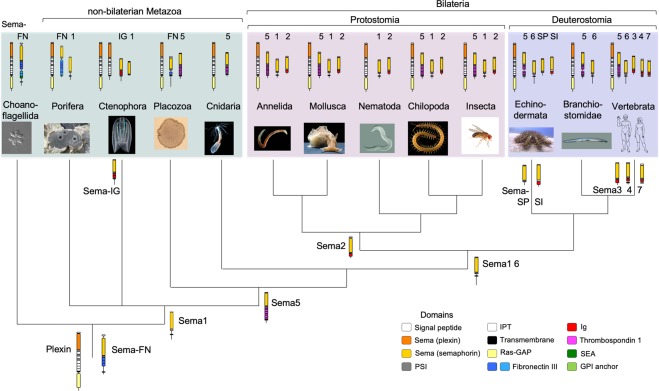Figure 8.
Model of evolutionary origin of plexins and semaphorins. Protein models above taxon names indicate presence of plexin and semaphorin classes in the respective clade (semaphorin class names denoted). Potential origins of semaphorin classes in ancestral lineages are indicated. A plexin and a class FN semaphorin may have been present in a common ancestor of Chonaflagellida and Metazoa. Loss of FN domains may have led to class 1 semaphorins of non-bilaterian Metazoa. The Sema5 class may have originated in a common ancestor of Placozoa, Cnidaria, and Bilateria (note absence in Nematoda). Semaphorins with Ig domains may have evolved twice independently, in Ctenophora as Sema-IG, and in Bilateria as classes Sema2, -SI, 3, 4, and 4. Protein domains: see legends of Figs 1, 3, and 4. Photo/image credits: M. brevicollis and S. rosetta: Mark Dayel64 (mark@dayel.com; http://www.dayel.com/choanoflagellates; CC BY-SA 3.0; https://creativecommons.org/licenses/by-sa/3.0/legalcode); A. queenslandica: Marcin Adamski; M. leidyi: William Browne; T. adhaerens: Oliver Voigt; N. vectensis: Eric Roettinger; C. teleta: François Michonneau (https://francoismichonneau.net/photos/capitella-telata) © 2018 by François Michonneau (CC-BY 4.0); A. californica: Genevieve Anderson; C. elegans: Bob Goldstein; S. maritima: Carlo Brena; D. melanogaster: Hans Smid; A. planci: Denis Zorzin; B. belcheri: Arthur Anker; H. sapiens: NASA.

